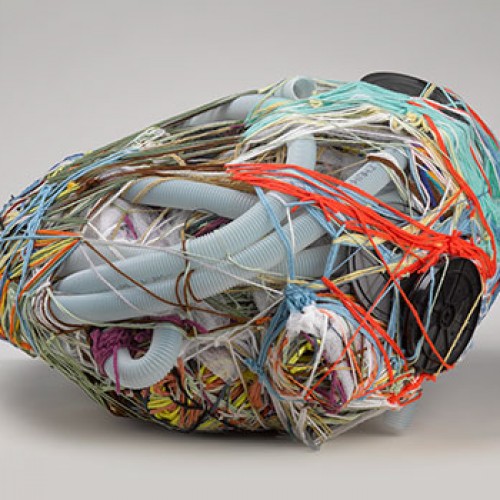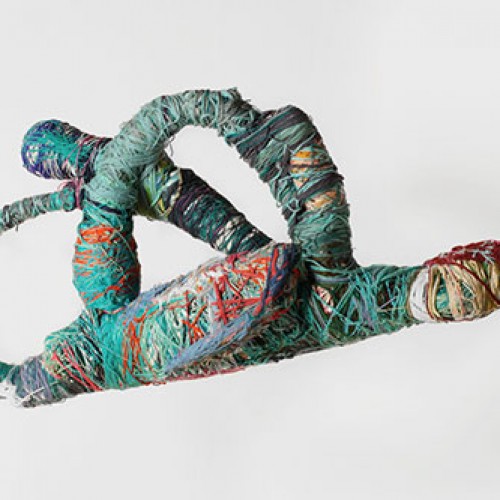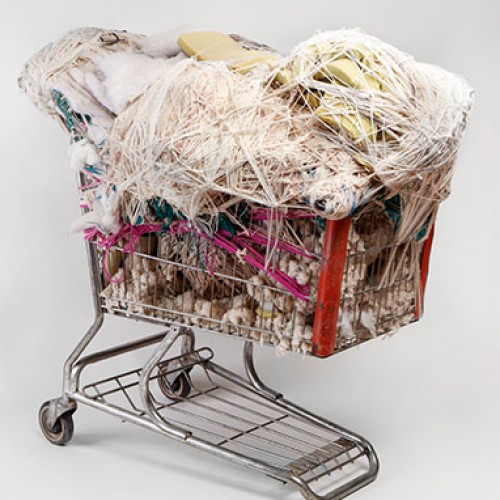Judith Scott: “Bound and Unbound” at the Brooklyn Museum
“Bound and Unbound” which is currently on right now at the Brooklyn Museum is the first ever retrospective of artist Judith Scott. The show is curated by Catherine J. Morris of the Sackler Gallery and Matthew Higgs director of White Columns Gallery. Drawing from her seventeen-year art making practice, the show features over forty sculptures and drawings that span Scott’s career. Many of the works in the show are objects that have been wrapped with various pieces of yarn, fabric and other materials that Scott worked with. The bundled package-like-sculptures sit on low display structures throughout the two rooms of the gallery’s space.
Born in 1943, with Down Syndrome, Judith Scott would go onto become an internationally recognized fibers artist. Scott spent the first thirty-five years of her life living in a institution geared towards individuals with disabilities. In 1987, she was introduced to the through her twin sister and legal guardian, Joyce Scott which helped to put her on a creative path. The CGAC was founded in 1974 in Oakland, California by artist Florence Ludnis-Katz and her husband psychologists Elias Katz. CGAC is still active today and offers art based programs and residencies to individuals with physical and mental disabilities. The time that Scott spent at CGAC would not only greatly change the way in which she would be able to communicate but also allowed her to grow as a person and artist. Scott was also famously featured on the cover of academic writer and queer theorist, Eve Sedgwick’s 2003 book Touching Feeling: Affect, Pedagogy, Performativity.
Many of Scott’s wrapped objects are recognizable but become distorted through the process that she has put them through. Scott’s process seems obsessive, meditative and labor intensive. The covered objects range in size and length and sometimes morph into one another. Some objects are more distinguishable than others such a as a wire hanger that has been wrapped in yarn and a musical instrument. Other objects are harder to make out and add to the the eccentricity of them. Another interesting element to Scott’s work is that all of her pieces remain untitled and are simply numbered. This not only adds to the ambiguity of the object but also leaves them more open to interpretation.
When Scott first started attending classes at CGAC she began to paint and draw. Over time she eventually enrolled in a class with fibers artist Sylvia Seventy. It was this class with Seventy which helped Scott to find her ideal medium—sculpture. Scott’s first sculpture, a cluster of sticks which she bound with yarn, cloth and twine which she added beads and paint to is featured in the exhibition. This particular sculpture set a precedent that Scott would revisit throughout her career although she would go on to create other works which deviated from this. The majority of Scott’s work was made sitting at a large table which is evident from the flat shapes they took and they way in which they could be easily hung which is apparent in the earlier work. Over time Scott’s piece would take on more complicated forms which is apparent in the work from the like 1990s through early 2000s.
One sculpture features a shopping card that has been filled to the brim with fabric and yarn and the top has been covered as well. Within the same room there is also a chair that has been wrapped in Scott’s quintessential fashion. They are beautiful and odd; and encompass many of the things that Scott was not able to verbally communicate but has done so through her own visual language. Although Scott had a limited way in which she was able to express herself, these works allowed for her to do so in another way. The show is incredibly thought provoking and makes one rethink the power that art has.
“Bound and Unbound” is on view until March 29th, 2015. The Museum is open Wednesday: 11 a.m.–6 p.m/Thursday: 11 a.m.–10 p.m./Friday–Sunday: 11 a.m.–6 p.m.
–Anni Irish




